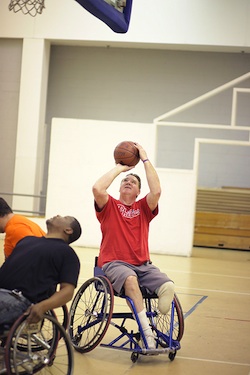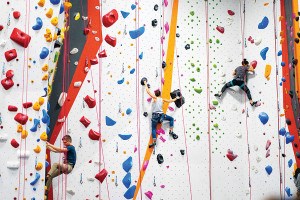I Tried It: Wheelchair Basketball with the Magee Sixers (Slideshow)
Of the four sports I played in high school, basketball was by far my favorite. (Track, softball and field hockey were the others, in case you’re wondering.) Our team was never that great (sorry, fellow former Lady Knights, it’s true), but that didn’t really matter. We had our plays, our cheers, our inside jokes, our nicknames (Lil Ems in the hoouuuuse!), and an awesome coach who also happened to be the school’s second-in-command, which meant we could weasel our way out of detentions pretty darn easily.
I didn’t play in college, so my glory days were in high school. Yes, I’m one of those—and I don’t care one bit. It was fun. Basketball was fun. And every winter around this time, I miss it dearly.
When Kimberly Shrack from Magee Rehabilitation contacted me last week about trying out wheelchair basketball with the Magee Sixers (as the name indicates, the team is sponsored by Magee and the Philadelphia 76ers), I don’t think I’ve ever been so excited—or answered an email so quickly. I was in, just name the place and time.
Of course, as soon as I agreed, I had questions—lots of questions. Like: Is it outdoors? (No.) Is it co-ed? (Technically, yes, but the team right now happens to be all men.) Would we use a men’s-size ball? (Probably, yes.) And the nets would be lowered since we’re playing sitting down, right? (Nope.)
Wait, come again? Kimberly informed me that just like regular ball, the rims would tower 10 feet over our heads. Forget having to maneuver a wheelchair, something I’ve never done in my life—would I be able to shoot anything other than air balls all night? This is when I realized things could go very, very badly. I decided to spend the week leading up to my wheelchair-basketball debut preparing my pride to take yet another blow, having learned my lesson after that time I embarrassed myself in front of worked out with the Philadelphia Eagles Cheerleaders.
Here we go again.
Last night was D-Day. The team gathered at the Carousel House in Fairmount Park at 6:30 for a grueling two-and-a-half-hour practice. Unofficial team spokesman Jim Falls got me set up in a special basketball-friendly wheelchair—the main differences being the 15-degree camber, or inward-tilting angle, of the wheels, and the chair’s weight, which was super light compared to regular wheelchairs—and explained a few of the rule differences. Players in wheelchair basketball get four seconds in the lane instead of three, for example. When you shoot a free throw, your wheel has to be behind the foul line (yup, same distance as in regular ball). To avoid traveling, you have to dribble the ball every two pushes. And you can’t smash into other people’s chairs—that’s a foul.
“You’re also not allowed to dunk or slap the backboard,” Jim deadpanned. When I finally got the joke, we both laughed.
There’s also something called a physical advantage foul, which we don’t see in stand-up hoops. It basically means that players have to say seated in their chairs and can’t use their legs or stumps, if they have use of them, to gain an advantage over other players by standing up when they shoot or defend. The rule exists because wheelchair basketball is open to people with a range of disabilities. Take Jim for example: He lost the lower half of his left leg in a freak Amtrak accident years ago but still has use of his right leg and his left stump. Paraplegics don’t have any use of their lower extremities, which means they’d be at a major disadvantage without this rule; same goes for some born with physical disabilities. When a physical advantage foul is called, it results in a technical foul shot being awarded to the other team.
Having use of both of my legs, this rule proved the most confounding. It was reeeeally easy to cheat, especially while shooting, to push off with my feet for a bit of extra momentum. This is why a lot of wheelchair players, like Jim, wear seat belts when they play; being physically strapped into their chairs makes staying in their chairs, well, a heckuva lot easier.
The other big difference between able-bodied basketball and wheelchair basketball is the point system—not how you score points, but how each player on the court is scored. Again, to accommodate a range of disabilities, each player is given a point value, or classification, based on ability level. These point values are determined for each player by officials in the National Wheelchair Basketball Association.
Depending on the league you’re in, a team’s total possible “balance score” cannot exceed 14 (some rules say 11, some say 12) during game play, determined by the combined player scores of the five guys on the court. And you can’t have more than three high-scoring players on the court at once. Make sense? Because Jim still has one leg and has use of his left stump, he has a higher score. Other players who are more disabled score lower. Jim says super talented low-score players are über valuable—and he’s got a few of them on his team.
Okay, I was primed. Now it was time to—gulp—get on the court. I took a few practice rolls in the chair to get acclimated. Huh, I thought, this is kinda hard. See, I fully anticipated not being able to shoot well while sitting down, but that actually turned out to be the least of my worries once I got the hang of it. What I didn’t anticipate was how dang slow those chairs actually move. To go fast, you have to expend what feels like way more energy than you get back in speed. I blame the weight of the chair—if they were a little heavier, you’d get more momentum once you got going. Sure, the first few pushes would be annoying, but once you reached cruising altitude you could just, well, cruise.
No such luck. I found myself huffing and puffing just to keep up. I jumped, er, wheeled as fast as I possibly could into lines behind the guys while we ran lay-up and shooting drills, trying not to slow them down. My shot honestly wasn’t half bad (I’ve still got it!), but good lord my arms and shoulder ached from the endless pushing.
The other thing I didn’t quite anticipate: how dirty my hands would get. (Before you leave a snarky comment, they looked way dirtier in real life than they do in the slideshow below, so shut it.) By the time we broke into teams to work on skills at either end of the floor, my hands looked like I’d just completed three miles worth of walking handstands around Center City. They ached a little, too, and I saw the beginnings of more than a few blood blisters.
“Our hands are our feet,” explained Keith Newerla, Magee’s wheelchair sports coordinator, who’s been in a chair for 29 years. “If I took my shoes off, you’d see my feet are pristine—no calluses, smooth as can be. But my hands are like the bottoms of most people’s feet.” Keith said he learned early on to stay away from wearing white. Noted.
I lasted about an hour and a half at the practice, which was an hour longer than I’d anticipated so I considered the evening a full success. The guys were really nice, helpful and, most of all, patient. Everything was all kumbaya until I wheeled off the court to watch them scrimmage (there was no way I had the chops for full-court play). And then, my friends, it was on. These guys were flying around, blocking shots, running plays, hollering, yelling, trash-talking—just like any other basketball game. It was awesome.
I told Keith how quickly you forget these guys are in wheelchairs. It’s like you’re just watching a bunch of really talented ballers who happen to sink three-pointers sitting down. You miss the squeak of basketball sneakers on wood courts, but it’s replaced by metal-on-metal crashes (yes, even though it’s technically illegal, contact still happens), which honestly is a bit more exciting and hardcore anyway.
In other words, these guys are legit; don’t count them out just because they’re sitting. They’ll give any able-bodied player a run for his or her money any day. Trust me—I know.
Created with Admarket’s flickrSLiDR.
>> Check out all our I Tried It posts here.




